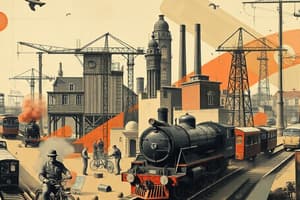Podcast
Questions and Answers
What was a significant advancement introduced by George Westinghouse in the electrical industry?
What was a significant advancement introduced by George Westinghouse in the electrical industry?
- Direct current (DC) power supply
- Alternating current (AC) power supply (correct)
- Compact electric motors
- Carbonized cotton thread for light bulbs
Which factor contributed to Thomas Edison's successful development of the incandescent light bulb?
Which factor contributed to Thomas Edison's successful development of the incandescent light bulb?
- His exclusive focus on electric motors
- The use of direct current (DC) throughout his experiments
- His collaboration with Alexander Graham Bell
- The financial backing from J.P. Morgan (correct)
What was one of the major impacts of the transcontinental railroad in the 19th century?
What was one of the major impacts of the transcontinental railroad in the 19th century?
- Stimulated the growth of other industries (correct)
- Reduction in the cost of telegraph services
- Greater isolation of rural areas
- Decreased demand for iron and coal industries
What term was used to describe the new millionaires who were often viewed negatively for exploiting workers?
What term was used to describe the new millionaires who were often viewed negatively for exploiting workers?
Why was the patent for the telephone considered highly profitable despite being short?
Why was the patent for the telephone considered highly profitable despite being short?
How much did the number of industrial workers increase between 1880 and 1920?
How much did the number of industrial workers increase between 1880 and 1920?
What were the two major processes that transformed steel production after the Civil War?
What were the two major processes that transformed steel production after the Civil War?
What was one major benefit of the inventions during this industrial era for household management?
What was one major benefit of the inventions during this industrial era for household management?
Which company was transformed into the American Telephone and Telegraph Company after acquiring Bell's patent?
Which company was transformed into the American Telephone and Telegraph Company after acquiring Bell's patent?
How did advancements in communication technologies affect message delivery during the late 19th century?
How did advancements in communication technologies affect message delivery during the late 19th century?
What significant change occurred in the number of patents issued by the U.S. Patent Office from 1860 to 1890?
What significant change occurred in the number of patents issued by the U.S. Patent Office from 1860 to 1890?
How did the development of commercial electricity impact industries by the end of the nineteenth century?
How did the development of commercial electricity impact industries by the end of the nineteenth century?
What was one result of the explosion of inventive energy in late nineteenth-century America?
What was one result of the explosion of inventive energy in late nineteenth-century America?
What was the primary motivation behind the surge of inventions in America during this period?
What was the primary motivation behind the surge of inventions in America during this period?
In what context did most Americans still live and work on farms as late as 1880?
In what context did most Americans still live and work on farms as late as 1880?
What practice did railroad owners use that disadvantaged local producers and farmers?
What practice did railroad owners use that disadvantaged local producers and farmers?
Which railroad magnate was known for exploiting other investors during his management of the Erie Railroad?
Which railroad magnate was known for exploiting other investors during his management of the Erie Railroad?
What was the primary way that railroads funded their rapid growth during the late 19th century?
What was the primary way that railroads funded their rapid growth during the late 19th century?
How did Commodore Cornelius Vanderbilt's approach differ from that of Jay Gould?
How did Commodore Cornelius Vanderbilt's approach differ from that of Jay Gould?
Which famous industrialist's early work included being a bobbin boy and later a telegram messenger boy?
Which famous industrialist's early work included being a bobbin boy and later a telegram messenger boy?
What was Andrew Carnegie's primary industry in which he made his fortune?
What was Andrew Carnegie's primary industry in which he made his fortune?
Which of the following best describes Carnegie's approach to wealth according to his beliefs?
Which of the following best describes Carnegie's approach to wealth according to his beliefs?
How did Carnegie suggest wealthy individuals should bestow charity?
How did Carnegie suggest wealthy individuals should bestow charity?
What role did Social Darwinism play in Carnegie's view of wealth and success?
What role did Social Darwinism play in Carnegie's view of wealth and success?
What was one of Carnegie's key business strategies during economic downturns?
What was one of Carnegie's key business strategies during economic downturns?
Flashcards
Late 19th Century Inventive Boom
Late 19th Century Inventive Boom
A period of significant invention and entrepreneurship in the United States, fueled by a desire for efficiency, comfort, and progress, driven by increasing industrialization.
Patent Office Growth
Patent Office Growth
The number of patents issued by the U.S. Patent Office saw a dramatic increase between 1860 and 1890.
Industrialization Surge
Industrialization Surge
The development of commercial electricity greatly expanded industrial output and led to concentration of industries in cities.
Rural to Urban Shift
Rural to Urban Shift
Signup and view all the flashcards
Impact of Inventions
Impact of Inventions
Signup and view all the flashcards
Quadrupled Industrial Workers
Quadrupled Industrial Workers
Signup and view all the flashcards
Steel Production Boom
Steel Production Boom
Signup and view all the flashcards
Telephone Impact
Telephone Impact
Signup and view all the flashcards
Improved Home Life
Improved Home Life
Signup and view all the flashcards
Urban Population Growth
Urban Population Growth
Signup and view all the flashcards
Telephone's impact (1900)
Telephone's impact (1900)
Signup and view all the flashcards
Edison's inventions
Edison's inventions
Signup and view all the flashcards
Incandescent light bulb
Incandescent light bulb
Signup and view all the flashcards
AC versus DC power
AC versus DC power
Signup and view all the flashcards
Railroad's impact (1890)
Railroad's impact (1890)
Signup and view all the flashcards
Robber Barons
Robber Barons
Signup and view all the flashcards
Differential Shipping Rates
Differential Shipping Rates
Signup and view all the flashcards
Jay Gould's Business Model
Jay Gould's Business Model
Signup and view all the flashcards
Cornelius Vanderbilt's Model
Cornelius Vanderbilt's Model
Signup and view all the flashcards
Andrew Carnegie's Success
Andrew Carnegie's Success
Signup and view all the flashcards
Carnegie's Steel Empire
Carnegie's Steel Empire
Signup and view all the flashcards
Gospel of Wealth
Gospel of Wealth
Signup and view all the flashcards
Social Darwinism
Social Darwinism
Signup and view all the flashcards
Self-Made Man Myth
Self-Made Man Myth
Signup and view all the flashcards
Andrew Carnegie's Business Strategy
Andrew Carnegie's Business Strategy
Signup and view all the flashcards




